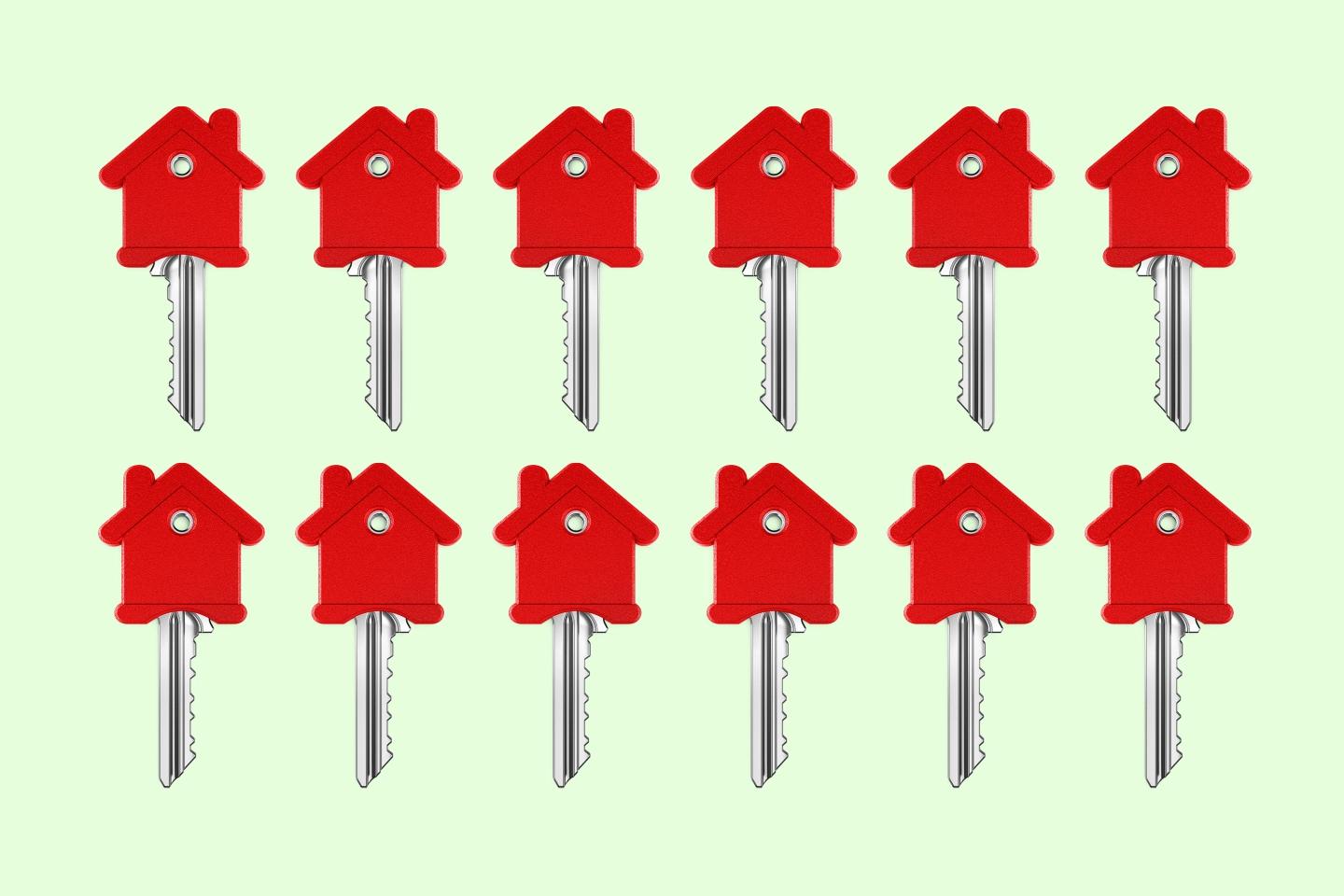
隨著高抵押貸款利率持續(xù)影響美國房地產(chǎn)市場,,購房人和賣房人都在越來越多地“買低”抵押貸款利率。
買低抵押貸款利率有不同模式,但通過2-1買低利率,,賣房人一次性支付一筆資金,,在第一年將購房人的貸款利率降低2個(gè)百分點(diǎn),在第二年降低1個(gè)百分點(diǎn),。到第三年,,購房人按照鎖定利率支付。
ANR Finance + Real Estate的首席執(zhí)行官兼登記經(jīng)紀(jì)人伊凡·坦登對(duì)《財(cái)富》雜志表示:“[購房人]在第一年和第二年節(jié)省大筆資金,,即使之后按照鎖定利率,,他們依舊能夠在前兩年調(diào)整好自己的財(cái)務(wù)狀況?!?/p>
如果購房人購買一套價(jià)值600,000美元的房子,,按照固定利率6%貸款570,000美元,月供約為3,417美元,。通過2-1買低抵押貸款利率,,在第一年,購房人的月供約為2,721美元(利率為4%),。第二年的月供為3,060美元(利率為5%),。因此,購房人在第一年節(jié)省了8,354美元,,在第二年節(jié)省了約4,291美元,。
坦登表示:“這種模式一直存在,只是過去幾年無人問津,,因?yàn)槿藗兏静恍枰?,尤其是?020年和2021年。但在2022年10月,,[抵押貸款利率]達(dá)到7%,,我們需要想辦法幫助人們有能力買到房子?!?/p>
但有幾件事情值得注意:購房人必須符合以完整利率貸款的資格(不同類型的貸款有不同資格要求),,而且省下來的資金并不會(huì)直接落入他們的口袋。這筆資金將被轉(zhuǎn)入一個(gè)托管賬戶,,當(dāng)利率下降時(shí),,這實(shí)際上對(duì)購房人有利。假如利率下降,,購房人可以選擇再融資并鎖定更低利率,,而托管賬戶中的資金依舊歸購房人所有,能夠作為信貸使用,。
坦登告訴《財(cái)富》雜志:“費(fèi)用由賣房人支付,。而且即使你進(jìn)行再融資,也不會(huì)損失這筆資金?!?/p>
你或許會(huì)想,,這樣做對(duì)賣房人有什么好處?畢竟根據(jù)上述情境,,賣房人需要支付超過12,600美元,?好處是他們可以在房地產(chǎn)市場下滑期間賣掉自己的房產(chǎn)。由于抵押貸款利率較史上最低點(diǎn)已經(jīng)翻了近兩番,,而房價(jià)在新冠疫情期間的房地產(chǎn)市場繁榮(Pandemic Housing Boom)中上漲了超過40%,,這導(dǎo)致市場缺乏可負(fù)擔(dān)性,房地產(chǎn)市場目前進(jìn)入回調(diào)模式,。
此外,,尤其是對(duì)于建筑商而言,這并非失去購房人的理想時(shí)期,,因?yàn)樗麄冃枰鎸?duì)與疫情相關(guān)的長期供應(yīng)鏈中斷和歷史性的房產(chǎn)庫存,。HomeLoans. LA的貸款經(jīng)紀(jì)人馬里奧·皮內(nèi)多對(duì)《財(cái)富》雜志表示,買低利率能夠縮小快速上漲的抵押貸款利率之間的差異,,而且有許多建筑商利用買低利率吸引購房人,以減少庫存,。
皮內(nèi)多說:“這是一種賣房人[提供的]激勵(lì),。”
他指出,,相比降價(jià)出售,,使用2-1買低利率對(duì)建筑商更有利,因?yàn)檫@種做法可以維持房產(chǎn)價(jià)值,,并且吸引購房人,。建筑商發(fā)現(xiàn)買低利率非常有效,因此許多建筑商提供超過兩年期限的買低利率,。
據(jù)約翰·伯恩斯房地產(chǎn)咨詢公司(John Burns Real Estate Consulting)統(tǒng)計(jì),,截至2022年12月,美國75%受訪的建筑商表示采用了買低購房人抵押貸款利率的做法,,以提高房產(chǎn)的可負(fù)擔(dān)性,。一些受訪的建筑商稱,“任何人都需要激勵(lì)”,,而“買低利率和/或鎖定利率最有效”,,而且“100%的庫存住房提供某種形式的買低利率,其力度與新房銷售的優(yōu)惠力度相當(dāng),?!?/p>
約翰·伯恩斯房地產(chǎn)咨詢公司負(fù)責(zé)研究業(yè)務(wù)的高級(jí)副總裁德文·巴克曼此前曾經(jīng)告訴《財(cái)富》雜志,買低利率“是鼓勵(lì)消費(fèi)者購買新房的工具之一?!保ㄘ?cái)富中文網(wǎng))
譯者:劉進(jìn)龍
審校:汪皓
隨著高抵押貸款利率持續(xù)影響美國房地產(chǎn)市場,,購房人和賣房人都在越來越多地“買低”抵押貸款利率。
買低抵押貸款利率有不同模式,,但通過2-1買低利率,,賣房人一次性支付一筆資金,在第一年將購房人的貸款利率降低2個(gè)百分點(diǎn),,在第二年降低1個(gè)百分點(diǎn),。到第三年,購房人按照鎖定利率支付,。
ANR Finance + Real Estate的首席執(zhí)行官兼登記經(jīng)紀(jì)人伊凡·坦登對(duì)《財(cái)富》雜志表示:“[購房人]在第一年和第二年節(jié)省大筆資金,,即使之后按照鎖定利率,他們依舊能夠在前兩年調(diào)整好自己的財(cái)務(wù)狀況,?!?/p>
如果購房人購買一套價(jià)值600,000美元的房子,按照固定利率6%貸款570,000美元,,月供約為3,417美元,。通過2-1買低抵押貸款利率,在第一年,,購房人的月供約為2,721美元(利率為4%),。第二年的月供為3,060美元(利率為5%)。因此,,購房人在第一年節(jié)省了8,354美元,,在第二年節(jié)省了約4,291美元。
坦登表示:“這種模式一直存在,,只是過去幾年無人問津,,因?yàn)槿藗兏静恍枰绕涫窃?020年和2021年,。但在2022年10月,,[抵押貸款利率]達(dá)到7%,我們需要想辦法幫助人們有能力買到房子,?!?/p>
但有幾件事情值得注意:購房人必須符合以完整利率貸款的資格(不同類型的貸款有不同資格要求),而且省下來的資金并不會(huì)直接落入他們的口袋,。這筆資金將被轉(zhuǎn)入一個(gè)托管賬戶,,當(dāng)利率下降時(shí),這實(shí)際上對(duì)購房人有利,。假如利率下降,,購房人可以選擇再融資并鎖定更低利率,,而托管賬戶中的資金依舊歸購房人所有,能夠作為信貸使用,。
坦登告訴《財(cái)富》雜志:“費(fèi)用由賣房人支付,。而且即使你進(jìn)行再融資,也不會(huì)損失這筆資金,?!?/p>
你或許會(huì)想,這樣做對(duì)賣房人有什么好處,?畢竟根據(jù)上述情境,,賣房人需要支付超過12,600美元?好處是他們可以在房地產(chǎn)市場下滑期間賣掉自己的房產(chǎn),。由于抵押貸款利率較史上最低點(diǎn)已經(jīng)翻了近兩番,,而房價(jià)在新冠疫情期間的房地產(chǎn)市場繁榮(Pandemic Housing Boom)中上漲了超過40%,這導(dǎo)致市場缺乏可負(fù)擔(dān)性,,房地產(chǎn)市場目前進(jìn)入回調(diào)模式,。
此外,尤其是對(duì)于建筑商而言,,這并非失去購房人的理想時(shí)期,,因?yàn)樗麄冃枰鎸?duì)與疫情相關(guān)的長期供應(yīng)鏈中斷和歷史性的房產(chǎn)庫存。HomeLoans. LA的貸款經(jīng)紀(jì)人馬里奧·皮內(nèi)多對(duì)《財(cái)富》雜志表示,,買低利率能夠縮小快速上漲的抵押貸款利率之間的差異,,而且有許多建筑商利用買低利率吸引購房人,以減少庫存,。
皮內(nèi)多說:“這是一種賣房人[提供的]激勵(lì),?!?/p>
他指出,,相比降價(jià)出售,使用2-1買低利率對(duì)建筑商更有利,,因?yàn)檫@種做法可以維持房產(chǎn)價(jià)值,,并且吸引購房人。建筑商發(fā)現(xiàn)買低利率非常有效,,因此許多建筑商提供超過兩年期限的買低利率,。
據(jù)約翰·伯恩斯房地產(chǎn)咨詢公司(John Burns Real Estate Consulting)統(tǒng)計(jì),截至2022年12月,,美國75%受訪的建筑商表示采用了買低購房人抵押貸款利率的做法,,以提高房產(chǎn)的可負(fù)擔(dān)性。一些受訪的建筑商稱,,“任何人都需要激勵(lì)”,,而“買低利率和/或鎖定利率最有效”,,而且“100%的庫存住房提供某種形式的買低利率,其力度與新房銷售的優(yōu)惠力度相當(dāng),?!?/p>
約翰·伯恩斯房地產(chǎn)咨詢公司負(fù)責(zé)研究業(yè)務(wù)的高級(jí)副總裁德文·巴克曼此前曾經(jīng)告訴《財(cái)富》雜志,買低利率“是鼓勵(lì)消費(fèi)者購買新房的工具之一,?!保ㄘ?cái)富中文網(wǎng))
譯者:劉進(jìn)龍
審校:汪皓
As the U.S. housing market continues to reel from spiked mortgage rates, buyers and sellers alike are increasingly turning to mortgage rate buydowns.
Mortgage rate buydowns can vary, but with a 2-1 rate buydown, a seller essentially pays a lump sum of money to reduce the buyer’s rate by 2 percentage points in the first year and 1 percentage point in the second year. By the third year, the buyer pays the note rate.
“[Buyers] save massive amounts of money in year one and in year two, even if they stick with the note rate, they have the first two years to get their finances in order,” Evan Tando, CEO and Broker of Record at ANR Finance + Real Estate, told Fortune.
If a buyer was purchasing a $600,000 home and took out a loan of $570,000 at a fixed rate of 6%, their monthly payment would be roughly $3,417. But with a 2-1 mortgage rate buydown, for the first year, their monthly payment would be around $2,721 (at a rate of 4%). And for the second year, their monthly payment would be $3,060 (at a rate of 5%). Therefore, the buyer is saving $8,354 the first year and around $4,291 the second year.
“It’s always been available, but no one was using it in the last several years because there really wasn’t a need, especially in 2020 and 2021,” Tando said. “But as we got to 7% [mortgage rates] in October, we really needed to figure out a way to get people in homes and to make it affordable.”
But there’s a couple things to note: the buyer must qualify for the full rate (qualification can vary depending on the type of loan), and the money isn’t just going directly into their pockets. Instead, it’s put into an escrow account, which actually works in the buyer’s favor if rates go down. So let’s say rates go down, then the buyer can choose to refinance and lock in that lower rate, but the money left in the escrow account still belongs to the buyer and can be used as credit.
“The seller is paying these fees,” Tando told Fortune. “And this is money that you will never lose, even if you refinance.”
So you may be wondering what’s in it for the seller, considering in the scenario above that it cost them over $12,600? Well, they sell their property in this slumped housing market, which is in correction mode because of the lack of affordability due to mortgage rates that have almost tripled from record lows coupled with home prices that rose more than 40% during the Pandemic Housing Boom.
Not to mention that for builders, in particular, it’s a less than ideal time to lose buyers as they grapple with long-lasting pandemic-related supply chain disruptions and a historic backlog. Mario Pinedo, a mortgage broker at HomeLoans.LA, told Fortune that rate buydowns are a way to bridge the gap between mortgage rates that have increased rapidly, and that a lot of builders are using the incentive to move their inventory.
“It’s a seller [offered] incentive,” Pinedo said.
It’s more beneficial for a builder to use a 2-1 rate buydown, Pinedo said, over a reduction in the sale price because it keeps the value up and entices buyers. Builders have found so much success with buydowns, many are offering buydowns that extend well beyond two years.
As of December of last year, 75% of nationally surveyed homebuilders said they’re buying down buyers’ mortgage rates to make it affordable, according to John Burns Real Estate Consulting. Some surveyed builders said that “everyone is requiring incentives,” and “rate buydowns and/or rate lock promotions are working best” and “100% of backlog is being offered some kind of rate buydown that is comparable to new sales.”
Devyn Bachman, senior vice president of research at John Burns Real Estate Consulting, previously told Fortune that rate buydowns “one of the levers that’s encouraging consumers to purchase new homes.”






